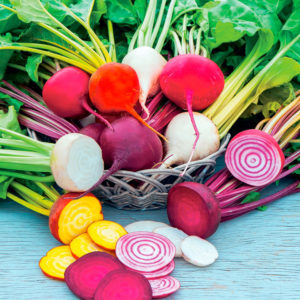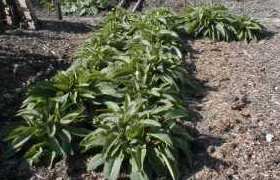Sometimes a simple question, like this one about white beetroot appearing amongst the red beets, opens up an interesting topic. Understanding why white beetroot are appearing from a packet of red Boltardy Beetroot seeds takes us into how we breed new varieties of vegetables.
This was the question I received:
I have been growing Boltardy Beetroot successfully every year. The last two years I have had the odd pure white beetroot amongst them. Last year I threw them away but this year I cooked one and tried it. Apart from the colour I couldn’t tell the difference. I wondered if you knew why this was happening.
My answer to the White Beetroot question:

A Coloured Beets Collection available from Suttons Seeds
That’s actually a really interesting question. Beetroot doesn’t just come in red varieties, there are white beetroot varieties, yellow / brown beetroot varieties and beetroot called chiogga beets or candy stripe which have alternating rings of white and red.
They’re all edible and some say the white and chiogga beets are sweeter whilst there are some claims that they lack antioxidants found in the red varieties. Personally I don’t think that really matters much when you eat a mixed diet.
Incidentally, carrots are a vegetable that we all think of being orange in colour yet they were bred from a white root and are available in a range of colours nowadays. Cauliflowers are another vegetable where more colours are available than the accepted white – purple, yellow and green.
Now the real question is “How are you getting the odd white beetroot appearing when you sowed red beetroot seed?”
Firstly, it’s nothing to do with the environment or cultivation methods. How you grow it will not change the colour of the beet. The cause lies in the seeds themselves. It’s not that some white beetroot seeds have got mixed into the packet either, it’s to do with how we breed varieties.
Distinct & Stable
To produce a new variety of seed that can be listed for general sale it must be distinct and stable. Distinct just means different to any other listed variety. That stops the same type of seed being listed under two or more names. Stable means the seeds must produce offspring similar to the parent. Let’s leave F1 varieties out of it for the purpose of this explanation.
Let’s say I find a pea plant that produces purple peas in a row of green peas. They grow well and taste wonderful so I can see fame and fortune lies in those pods! I save the seed and sow them but only half grow to have purple peas, the rest have reverted to green.
The next year I sow only the purple peas and fewer come up green. By repeating and selecting just the purple peas, after some generations I have a distinct variety that is stable. Only rarely does a plant come up with those old fashioned green peas, but even after many generations a plant will occasionally revert to the old type.
It’s just the same with the white beetroot appearing occasionally amongst the red. It’s
very rare but not unknown. I’m sure a trained biologist or geneticist could give a more extensive and technical answer but I’m neither of those.
Mystery solved, I hope.





I just picked a Beetroot out of our normally red Beetroots we have growing. The outside (skin) is red as normal, but the inside is white – is it OK?
I thought I said that it was OK in the article – yes.
Thanks for article- I was quite riddled with this green plant growing amongst the other red leaves of the other beet root plants. I unfortunately discarded the plant . Should have read your article before harvest!
Thank you for the explanation. I have cooked the ring varietie and I also thought it was sweeter also very nice
I also found a green plant and white root in my garden…good to know why it occurred among my red beets! Better yet to know it is edible and may be even better. It will be a good taste test. Good article, thanks.
I’ve found one among my red beets 2 x. Darn, I tossed it last year, this year I will try it. Your explanation of how it got there makes alot of sence.
Thanks!
For the first time, I got a white beet with my red. The sweet taste surprised me-almost like sugar.
this is the second year that all my beets about 20+ are turning completely white. they taste as good but i am puzzled why all are turning white. i do not remember if all seeds are from same seed bags. i harvest spring. i will try different variety this year.
I planted my bollardy beetroots in a raised bed. This is my first year (I retired last year).
Anyway, your article on red/ white beetroots imply that I may get the occasional white beet. Almost 60% have been lifted and they are white. They are currently in the pot to boil. Thank you. Hope that my input helps.
Until I discovered this post I was completely baffled by my one white beetroot much bigger than the rest of the bought purple Boltardy that I sowed – thank you!
I had three or four white beets mixed with my Detroit
Reds and left one to grow. I pulled it on Halloween and it weighed nine and one half pounds and measured 7 1/2” x 9 1/2”.
I am from UK, had gardens, allotments all my life, grew red, yellow and chiogga beetroot. i now live in Thailand, this evening was served a meal, I asked… what is that white vegetable ? The reply was… white beetroot, it is common here.
Yes, we have the same with this huge white vegetable growing amongst the red beetroot. Thought it was a horrible turnip to start with and just let it grow. Have now picked it and it smells like an ordinary beetroot so in the pot it goes. It weighs 1.66 Kg. We are from Sunshine Coast Queensland Australia.